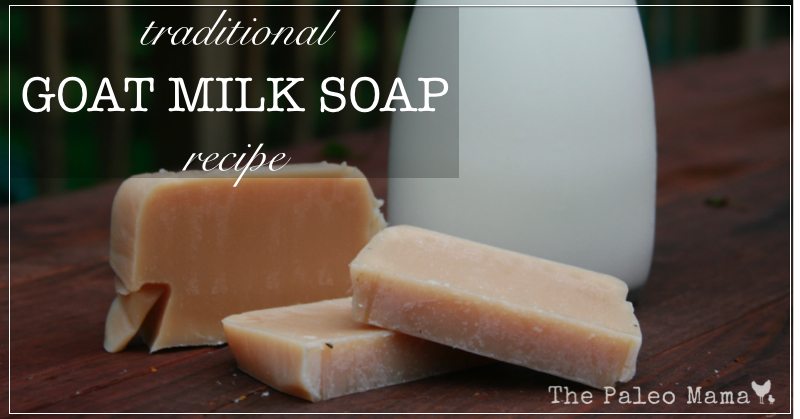

Why Goat’s Milk
Goat’s milk is packed with vitamins, minerals natural fats, and protein. It carries a pH of around 6.4 which is very similar to a normal skin pH of 5.6, which makes it great for skin tolerance. You can find vitamins A, B2, B6, B12, and Niacin in goat’s milk and many who cannot tolerate dairy, find that they have no problems with goat’s milk.
Those who have very sensitive skin, find that paying over $5 for a bar of goat’s milk soap is worth it! I’ve had several people come up to me and tell me that my soap was the one of the only bars of soap that they could use without breaking out or having a skin reaction.
Anyone Can Make Soap
Soap is NOT hard to make. What is hard to make is all that fancy soap…which I don’t understand anyways. It’s just you, naked in the shower or bath, rubbing a bar of soap on your body. Why do you need swirls and fun shapes? If you enjoy doing that, then by all means, go for it! But I make soap for my family and most the time the kids end up making holes in the bar and pretending like Spiderman can surf on it.
This is a very basic, traditional recipe that I created. I use lard and I use lye. This is NOT a vegan recipe. I also use the traditional method of cold-process. This process uses a short prep time and a long cure time. It’s the easiest, in my opinion, because you are mostly waiting on the soap to cure and harden. This is the way our ancestors prepared soap and it’s the way I prefer to make my soap. Since I use raw goat’s milk, I prefer to keep the milk unheated to prevent destroying any vitamins and minerals.
Why Lard and Lye
Lard was traditionally used in making soap and has a very long history of in soap-making. I get my lard from a local farm for a really good price, but you can order pastured lard from here. Lard is the hardening fat in this soap – it’s what makes the bar hard so that it doesn’t turn into a big pile of glob while you are taking a shower.
I, also, like lard because of the aging time. When you make a cold-process soap, you are going to need to let your soap age (or cure) for 3-6 weeks. If you do not use a hardening fat, like lard, then it’s going to take your soap much longer to cure. I find that 3-4 weeks is perfect for this recipe.
Now lye is necessary for the alkali, when combined with the goats milk, loosens and attracts dirt, allowing it to be washed away. After 24 hours, the lye is not even present and by the time the 3-4 weeks is up, there is no trace of lye in the soap.
Supplies Needed:
For anything that touches the lye, you will need separate supplies and those supplies should never be used on anything else. Also, this is going to make an UNSCENTED bar. I have tried using essential oils and it requires way TOO MUCH. Alternatively, if you would like, you can add a few drops of essential oil to your bar of soap when you are washing in the shower.
- Immersion blender
- Glass bowls for mixing
- Rubber spatulas
- Digital Kitchen Scale
- Tall stainless-steel pot for melting oils
- 2 Thermometers
- Safety Equipment – rubber gloves, long sleeve shirt, and goggles
- Knife to cut the soap
- Soap Molds or Old Loaf Pans – I prefer the rustic cut of the soap and prefer to use loaf pans.
- Parchment paper
Ingredients Needed:
You can change your fats and oils if you would like. This is just the recipe that I created and enjoy the most. I have made several other recipes and I really prefer mine as it is very moisturizing, lathers very well, and includes sustainable fats.
- 2 ounces of Beeswax
- 18 ounces of Coconut oil
- 5 ounces of Castor Oil
- 26 ounces of pastured Lard
- 6 ounces of Olive oil
- 8.40 ounces (or 238.39 grams) of 100% pure Lye
- 18.9 ounces of Frozen Goats Milk (raw or pasteurized) – easiest way to freeze goats milk for soap-making, is to pour the measured out goats milk into a gallon ziplock bag. Then freeze the bag flat.
Step-By-Step Instructions:
- Collect all your supplies and block off your kitchen. I usually do this when my kids are down for a nap because of the lye.
- Put parchment paper in your loaf pans to get them ready.
- Measure out all the fats and oils (everything but the lye and milk) and put in your tall stainless-steel pot.
- Put your stove on LOW and slowly melt the oils and the fats. Put a thermometer in and make sure it never goes above 100 degrees. Once melted, remove from stove.
- Take your bag of frozen goats milk and smash it up into smaller pieces. Add it to a large glass bowl.
- Slowly sprinkle your lye over the frozen milk and mix with a spatula at the same time. MAKE SURE you are wearing your safety gear!
- Mix until the frozen milk is melted. Check the temperature of the mixture with a thermometer and do not let it go over 110 degrees. If it does, no worries, just cool it down by placing the bowl in a larger bowl filled with ice water.
- Now check on your oils and make sure they are melted and the temp is not over 100 degrees. If it is, then cool it down by placing it in the bowl of ice water.
- You want your oil mixture and your lye mixture to be within 10 degrees of each other.
- Now slowly pour your lye mixture into your oil mixture. As you are pouring, put your immersion blender on LOW and start to mix.
- When all the lye mixture is added, turn your immersion blender on HIGH and mix until you reach “trace”. Trace is when you can take a spoon or spatula and you can draw a line in your mixture. It usually takes me 2 minutes to reach trace with this recipe…sometimes less.
- Once you reach trace, you are going to need to move very fast. Immediately, pour your mixture into your 2 loaf pans or your soap molds. Use your rubber spatula to clean the bowl and smooth out the top of the loaf pan.
- Put the pans in a dark spot out of reach of kids. Leave it alone for 24 hours. After around 24 hours, the lye is inactive and you can touch the soap.
- After 24 hours, remove your soap from the loaf pans and cut into individual bars.
- Place the bars in a dark area and let them cure for 3-4 weeks! I know, it’s torture to wait, but it’s sooooo worth it!
- After 3-4 weeks the bars should be ready to go!
See Picture Tutorial Below…..
Working on reaching trace.
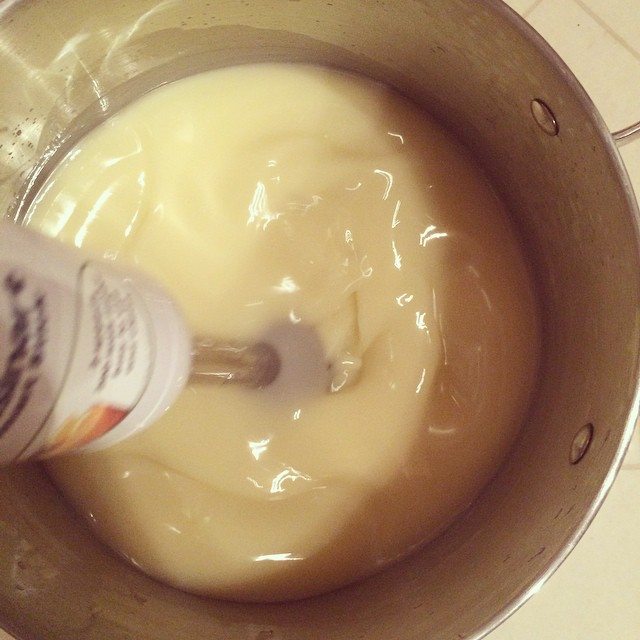
After you reach trace, pour into your loaf pans and allow to sit for 24 hours.
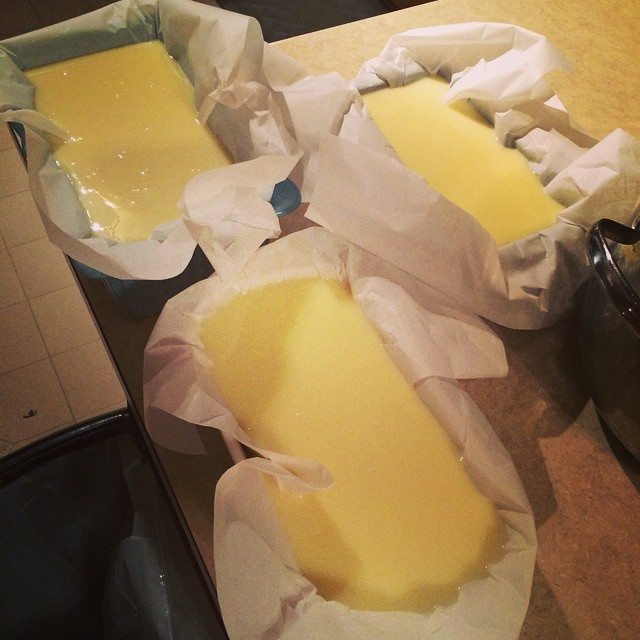
After 24 hours, cut into individual-sized soap bars and cure for 3-4 weeks.
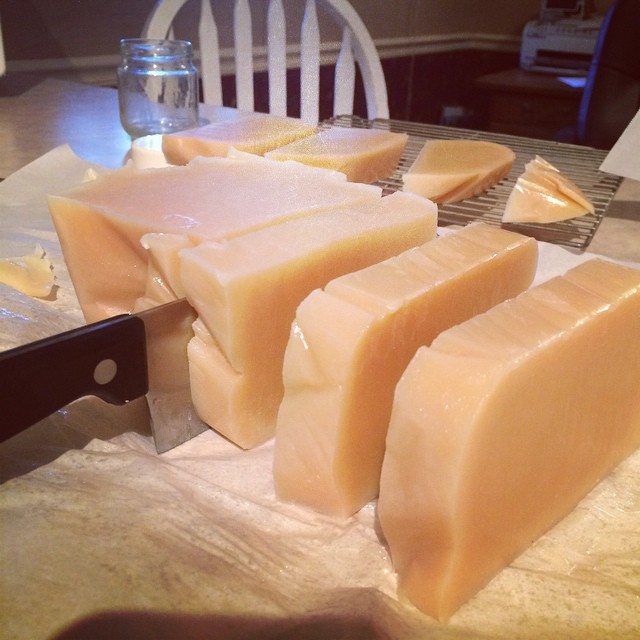
Waiting 3-4 weeks for the soap to harden! It’s worth the wait!
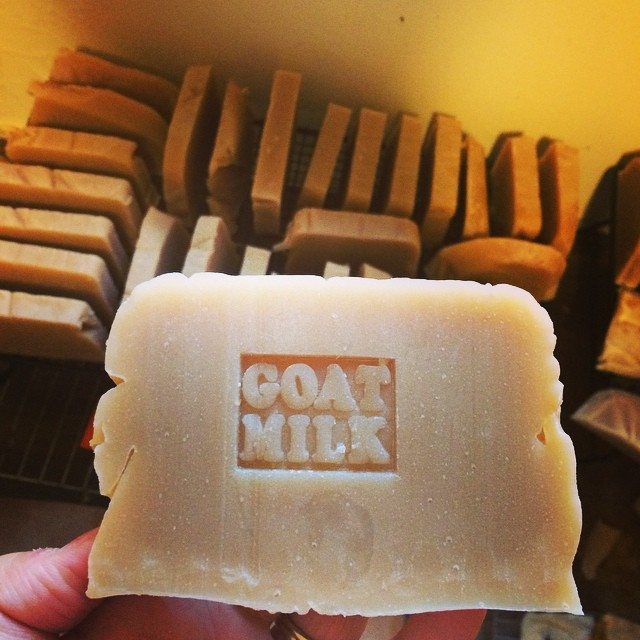
I hope you enjoy this recipe as much as my family does!
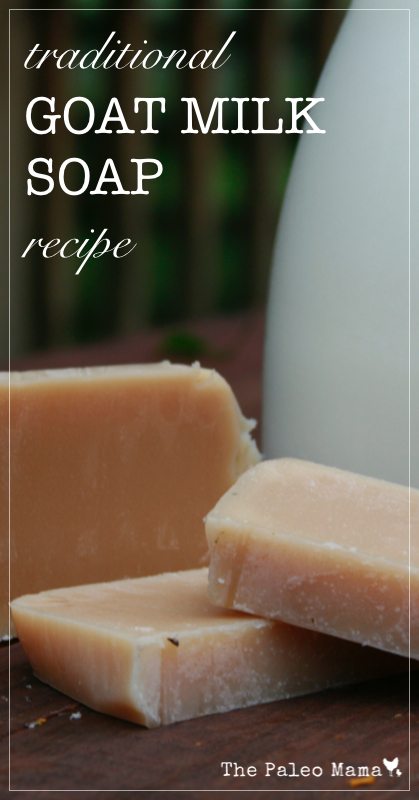
Does this soap need to be refrigerated? How long can it be stored?
No you don’t need to put it in the refrigerator.
I know very little about making soap, but I think it would be fun and rewarding. Thank you for the recipe. In the instructions, you said to mix the frozen Goat’s milk and Lye in a glass bowl – don’t let it get over 110 degrees. Pardon my ignorance, but does the lye create heat or am I missing something? Thank you for an answer. Love your blog.
Yes lye creates heat which is why you use frozen goat milk because it will heat it up too much otherwise and ruin the healthy proponents of the raw milk
Thank you very much for this simple recipe. I have made cp soap since 2010 and we recenlty got goats so I have milk in the freezer for soap. I have heard the lye get hotter than normal with goat’s milk so I am waiting until my husband is home in case something bad happens.
For 1st timers one thing I love is that you make one batch and it last for a really long time.
I think you will really enjoy making this soap.
Since I need the soap only for one, can the recipe be cut in half?
Yes, I think that would be fine.
Hi! I’ve never made soap before, but would like to try it. How do you clean your supplies when you are finished?
I keep a set of supplies that I only use for soapmaking.
I keep a dishpan with hot water, soap and vinegar handy for my stick blender, bowls, pots and pans, etc.nThe vinegar helps neutralize any lye left on my tools. Many soap ers recommend to keep your goggles and gloves on when cleaning your soap utensils because raw soap batter is caustic and could irritate your skin if you get it on you. This is a great article, just a suggestion.
Thank you for the recipe. I am always looking for new goat milk soap recipes. Just a couple of things. I always mix the frozen milk and lye outside. the reason why is because of the fumes. You do not want to inhale them. I am excited to try this recipe since we just made a fresh batch of lard. I have never made my soap with lard.
I was wondering if you have ever used beef tallow in your soap recipes, and if so, could I substitute that for the lard?
Do you have any beef tallow soap recipes as I have rendered about 10 pounds of it and would love to use it?
I have not used it but I know that you can. Here’s a link to 3 easy recipes using beef tallow. https://beeftallow.com/uses-of-beef-tallow_3-easy-to-make-tallow-soap-recipes-for-the-novice-soap-maker_38.html
Hi, If I used a fragrance oil, should I reduce the amount of olive oil to equal and add the fragrance oil?
Angie
I was wondering about the color of the soap. How do you keep it from turning the orange color when you add the milk? I thought the milk would react like if you added honey to it. I heard the soap can turn a bright orange. Has that ever happened to you using goat’s milk?
If you add the lye too quickly, it heats the milk up too fast and causes it to scorch, which is how you get the orange color.
Please, please, please… if you make ANY change to this recipe, check your recipe using a lye calculator! I cannot stress that enough. Oils have different lye requirements. Also, if you’re reducing the recipe, run it through a lye calculator!! Always, always, always!!
Also, wait the full 6 weeks. Even though your soap may be hard, there are things going on that you can’t see. Trust me, it will be worth the wait!
I put my goats milk in ice cube trays to freeze and then put the cubes in a bag so I always have it on hand when I feel the urge to make soap. Its also easier to weigh out if I want to change the amount of soap I make.
Can something be substituted for beeswax. I have all ingredients except the beeswax. What does beeswax add to cured soap? Thanks I try not to have to buy too many products when trying new soaps
I was finally able to use my soap that I made using your recipe and it is amazing! I used it on my kids and even as a shampoo for my son. I think next time I would like to add a scent to it. I’m new at soap making and this was my first batch so I’m not sure how to go about adding a scent to your recipe.